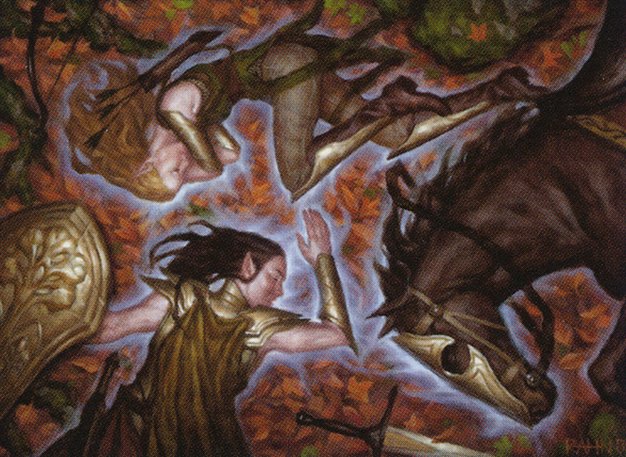Exhaustion in D&D 5e
Published on May 10, 2021, Last modified on March 8th, 2024
Exhaustion in D&D 5e is a tiered condition that represents the effects of fatigue creatures experience when exposed to physical exertion, lack of sleep, or extreme environments.

Table of Contents
What is Exhaustion in D&D 5e
Exhaustion, much like Poisoned or Grappled, is a condition that can be applied to a creature when they are exposed to particularly draining circumstances in D&D 5e. The way exhaustion works is similar to other conditions in that when a creature is exposed to a catalyst for exhaustion, they are required to make a Constitution saving throw or become afflicted by the condition.
While this may sound familiar, exhaustion works differently than other conditions because there are 6 different levels that have effects that stack based on how many times the creature has been exposed to the exhausted condition and how many times they have failed their save.
Exhaustion is unique when compared to other conditions because, first and foremost, it is a condition to represent the effects of pushing one’s self beyond normal limits. Exhaustion is featured prominently in the Player’s Handbook Chapter 8: Adventuring. It is described as a result of eating too little, traveling too far and too fast, or exposure to extreme environments.
D&D 5e Exhaustion Rules
When a creature fails a saving throw against exhaustion, they gain one or more levels of exhaustion, depending on the effect. If a creature already has a level of exhaustion, they continue to gain additional levels.
For example, when your Berserker Barbarian comes out of their Frenzied Rage, they will gain one level of exhaustion. They are then exposed to extreme heat and fail their CON saving throw. This means your Barbarian now has two levels of exhaustion and suffers from both the first level and second level’s effects.
Levels of Exhaustion 5e
The six levels of exhaustion are as follows. The effects of these levels start fairly innocuous but quickly evolve into dangerous disadvantages because of the exponential nature of the condition.
| Level | Effect |
| 1 | Disadvantage on ability checks |
| 2 | Speed halved |
| 3 | Disadvantage on attack rolls and saving throws |
| 4 | Hit point maximum halved |
| 5 | Speed reduced to 0 |
| 6 | Death |
Below is an in-depth look at each level, what it means, and its implications.
Exhaustion Level 1
Disadvantage on ability checks isn’t great but it’s also easily avoided. In combat, ability checks are quite rare unless you are playing a grappling build or a Rogue that likes to bonus action Hide. Outside of combat, you can sit back and provide the Help action to party members that need to make ability checks while adventuring. It can also be remedied easily as single long rest with food and drink can cure your exhaustion.
Exhaustion Level 2
Having your speed halved is again not the worst thing in the world. Of course, the main disadvantage when you have two levels of exhaustion is not being able to travel as far over a single adventuring day. This won’t always be a problem, but if you are trapped in an extremely hot or cold environment that is causing your exhaustion you likely want to get out of there as quickly as possible.
This level also starts to drastically affect your performance in combat. Melee fighters will feel this effect the hardest, as it will be much harder to get close to enemies and protect weaker party members.
Exhaustion Level 3
The third level of exhaustion is where things start to get really nasty. Disadvantage on attack rolls, saving throws, ability checks, and half movement is a massive debuff for almost any character.
Some builds, specifically full caster builds, will likely be able to use their spells to brush the majority of these effects aside, but melee and ranged builds will see a severe drop in effectiveness in combat.
This level is also particularly dangerous because it will make you roll death saving throws with disadvantage. The math behind disadvantage is quite complex but it works out to give a -5 to a roll that needs 11 to pass, like death saving throws. This means that there is a 25% greater chance of death when rolling death saves with exhaustion level 3.
All things said and done, if you get to the third level of exhaustion make it your utmost priority to get the condition resolved.
Exhaustion Level 4
Having your hit point maximum reduced by half is dreadful at any level. This, combined with the fact you’ll be making death saves with disadvantage, means that if you hit the fourth level of exhaustion, you are in dire straits.
Exhaustion Level 5
The cherry on the cake of exhaustion. The only cure for not being able to move is to remove a level of exhaustion. If you are still in dangerous territory by this point, it may be too late.
Exhaustion Level 6
Getting to the sixth level of exhaustion means death. No unconsciousness, no saving throws. Similar to getting your Strength drained by a Shadow, reaching the sixth level of exhaustion is game over (barring resurrection spells, of course).
What Causes Exhaustion 5e?
There are a number of effects that cause exhaustion. The following is more of a reference than a complete list:
Monsters with Exhaustion Effects
- Gingwatzim (CR 2) – Energy Drain action
- Jade Tigress (CR 6) – Poison Dart action
- Soul Monger (CR 11) – Wave of Weariness action
- Sibriex (CR 18) – Warp Creature feature
- Kalaraq Quori (CR 19) – Mind Seed feature
DnD 5e Spells That Cause Exhaustion
As of now, only Sickening Radiance can inflict a level of exhaustion on another creature. The only other spell that causes exhaustion is Tenser’s Transformation, which can cause a level of self-inflicted exhaustion if you fail a saving throw when the spell ends.
Exhaustion While Travelling 5e
As mentioned previously, exhaustion is primarily a mechanic to address overexertion while adventuring. This means that any extreme circumstances can cause a level of exhaustion. This includes, but is not limited to:
- Not eating or drinking enough
- Exposure to extreme heat or extreme cold
- Traveling for longer than 8 hours in a day
- Going 24 hours without a long rest
- Falling into frigid water
- Swimming for more than 1 hour
- Rowing a boat for longer than 8 hours
Going Without a Long Rest
Xanathar’s Guide to Everything specifies that going for 24 hours without sleep will cause you to make a DC 10 CON saving throw or gain a level of exhaustion. As you stay awake for longer, the save DC gets harder, increasing by 5 for each 24 hours you go without long resting. Luckily, the DC resets to 10 after you finish a long rest.
Class Features
The only known class feature to give exhaustion is the Berserker barbarian, who gains a level of exhaustion after going into a frenzied rage.
Ways to Remove Exhaustion 5e
Sleep/Long Rest
The simplest way to remove a level of exhaustion is by completing a long rest, assuming that food and water is also ingested as part of the long rest. The one caveat to this is if you slept in medium or heady armor, sleep doesn’t reduce your exhaustion level. Sleeping in light armor is fine for reducing exhaustion, however.
Keep in mind that if you are still exposed to extreme heat or cold during a long rest, saving throws against exhaustion will need to be made.
Class Features
In Tasha’s Cauldron of Everything, the Deft Explorer feature allows 10th-level rangers to reduce 1 level of exhaustion on a short rest.
Spells
Barring magical artifacts, the only other way to fix exhaustion is to use the Greater Restoration spell, which can reduce the target’s exhaustion level by one.
Conclusion
Thanks for reading our breakdown of the exhaustion mechanic! Exhaustion is a very interesting tool for DMs to use to switch up the dangers their adventuring parties may run into. Understanding how exhaustion works and what impacts the condition has is very important when looking to use the mechanic effectively in your campaigns.
Have you used exhaustion in interesting ways? We’d love to hear about it in the comments below!

Re: “Exhaustion is featured prominently in the Dungeon Master’s Guide Chapter 8: Adventuring.”
I believe you meant: “Player’s Handbook Chapter 8: Adventuring.”
Whoops! You’re right, I’ve fixed this!
In Tasha’s, the Deft Explorer feature allows Ranger 10 to reduce 1 level of exhaustion on a short rest. So Greater Restoration isn’t the only other way to remove exhaustion.
Added to the guide!
So if I cannot sleep due to random encounters I will suffer for 1 level of exhaustion?
Well, if you go 24 hours without sleep or a long rest, you have to make a DC 10 CON saving throw or gain 1 level of exhaustion. Usually, random encounters won’t last longer than 1 hour, which is the maximum amount of time you can perform strenuous activity and still benefit from a long rest.